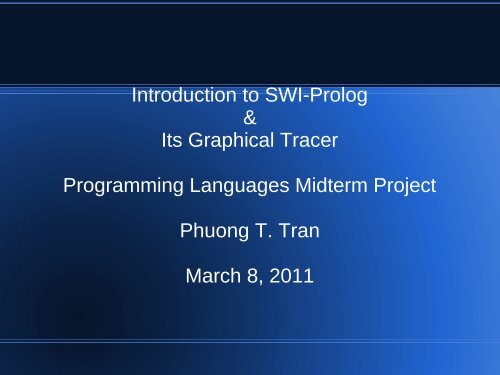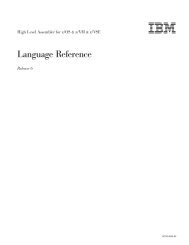Introduction to SWI-Prolog & Its Graphical Tracer Programming ...
Introduction to SWI-Prolog & Its Graphical Tracer Programming ...
Introduction to SWI-Prolog & Its Graphical Tracer Programming ...
Create successful ePaper yourself
Turn your PDF publications into a flip-book with our unique Google optimized e-Paper software.
<strong>Introduction</strong> <strong>to</strong> <strong>SWI</strong>-<strong>Prolog</strong><br />
&<br />
<strong>Its</strong> <strong>Graphical</strong> <strong>Tracer</strong><br />
<strong>Programming</strong> Languages Midterm Project<br />
Phuong T. Tran<br />
March 8, 2011
What is <strong>Prolog</strong>?<br />
●<br />
●<br />
<strong>Prolog</strong> is:<br />
– A logic programming language<br />
– A declarative language<br />
– Comprised of:<br />
●<br />
●<br />
●<br />
Facts<br />
Rules<br />
Queries<br />
Useful in specific problems like AI and<br />
scheduling.
Facts<br />
●<br />
●<br />
●<br />
has(bicycle,wheel,2).<br />
This fact states that a bicycle has wheel, two of<br />
them.<br />
Other examples of facts:<br />
– has(wheel,spoke,32).<br />
– has(bicycle, frame,1).
Rules<br />
●<br />
●<br />
abs(X,Y) :- X >= 0, Y is X<br />
This rule states that for the predicate<br />
”abs(X,Y)” where X is the parameter inputed,<br />
and Y is the result.<br />
● If X >=0, then Y is X.<br />
●<br />
This abs predicate is part of defining the<br />
absolute value of X. The other part is:<br />
● abs(X,Y) :- X < 0, Y is X * -1
Queries<br />
●<br />
Using the Facts from the earlier slide, here is<br />
an example of a query:<br />
– par<strong>to</strong>f(wheel,spoke).<br />
– Is spoke part of wheel?<br />
●<br />
Using the abs predicate rule:<br />
– abs(-1,Y).<br />
– What is the absolute value of -1?
Is an IDE Necessary for <strong>Prolog</strong>?<br />
●<br />
●<br />
●<br />
Starting off with <strong>Prolog</strong> only needs two <strong>to</strong>ols:<br />
– The <strong>Prolog</strong> compiler/implementation<br />
– Text Edi<strong>to</strong>r<br />
IDEs typically provide the following <strong>to</strong>ols:<br />
– A ”project/explorer” view for multiple files &<br />
dependencies<br />
– <strong>Graphical</strong> debugger<br />
– GUI development <strong>to</strong>ols<br />
Of the above, a graphical debugger may be the most<br />
useful part of an IDE for teaching and learning.
Launching <strong>SWI</strong>-<strong>Prolog</strong>
Let's Use the abs(X,Y) Rules<br />
abs(X,Y) :- X >= 0, Y is X<br />
abs(X,Y) :- X < 0, Y is X * -1<br />
And compile...
Result of a Query<br />
● The following is the of the query that inputs -1<br />
and asks for the absolute value of -1.<br />
● The result is Y = 1.
Using trace.<br />
●<br />
Typing in ”trace.” at the <strong>Prolog</strong> prompt allows<br />
you <strong>to</strong> trace the step of execution. This is very<br />
useful as a debugging <strong>to</strong>ol, especially for more<br />
complex programs.
Tracing abs(-1,Y)
<strong>Graphical</strong> <strong>Tracer</strong><br />
●<br />
Type in the following <strong>to</strong> launch the graphical<br />
tracer and trace the abs(X,Y) predicate.
Parts of the <strong>Graphical</strong> <strong>Tracer</strong><br />
●<br />
The graphical tracer has three main parts:<br />
– Bindings<br />
– Call Stack<br />
– Program steps<br />
●<br />
Everything is color coded.
Step 1<br />
●<br />
The green highlights the first step.
Step 2.<br />
●<br />
The next step is <strong>to</strong> consider the first condition:<br />
X > = 0.
Step 3.<br />
●<br />
Condition is false, as highlighted in red.
Step 4.<br />
●<br />
The debugger continues on <strong>to</strong> the next<br />
condition: X < 0.
Step 5 & 6<br />
●<br />
Green indicates that the condition is true.<br />
Evaluates Y = X * -1. Program then exits.
Other Components of <strong>Graphical</strong><br />
<strong>Tracer</strong><br />
●<br />
Thread viewing for more advanced programs
Other Components (cont.).<br />
●<br />
●<br />
●<br />
A Naviga<strong>to</strong>r <strong>to</strong> view all components<br />
of a program<br />
Useful for larger programs that is<br />
comprised of many files.<br />
Query Insert:
Console vs. <strong>Graphical</strong> <strong>Tracer</strong><br />
●<br />
●<br />
The Console and <strong>Graphical</strong> <strong>Tracer</strong> providers<br />
the same information.<br />
The <strong>Graphical</strong> <strong>Tracer</strong> advantages<br />
– Color coding debugger and text edi<strong>to</strong>r<br />
– Easier <strong>to</strong> view longer, more complex predicates<br />
– Other Functions:<br />
●<br />
●<br />
●<br />
Edit program within debugger<br />
Set breakpoints<br />
Run queries within debugger.
<strong>Graphical</strong> <strong>Tracer</strong> as a Learning<br />
Tool<br />
●<br />
●<br />
●<br />
●<br />
Dividing the tracing in<strong>to</strong> three sub windows allow for<br />
easier viewing of the steps and stack calls.<br />
Color coding helps <strong>to</strong> track steps, especially with<br />
complex predicates, such as recursions.<br />
Ability <strong>to</strong> edit, query, and compile in debugger saves<br />
time from editing in text edi<strong>to</strong>r and then compiling in<br />
different window.<br />
Better for visual learners <strong>to</strong> see the background of<br />
stack calls and step throughs.
Another IDE – Visual <strong>Prolog</strong><br />
●<br />
●<br />
Other IDEs exist, some more complex than the<br />
<strong>to</strong>ols that come with <strong>SWI</strong>-<strong>Prolog</strong>.<br />
Visual <strong>Prolog</strong> is an IDE for a Windows OS.<br />
– Text Edi<strong>to</strong>r<br />
– Compiler, Linker, and Debugger<br />
– Additional <strong>to</strong>ols for developing GUIs, such as a<br />
graphics edi<strong>to</strong>r, <strong>to</strong>olbar edi<strong>to</strong>r.
Summary<br />
●<br />
●<br />
A graphical debugger, such as provided with<br />
<strong>SWI</strong>-<strong>Prolog</strong> can be a very useful<br />
teaching/learning <strong>to</strong>ol for <strong>Prolog</strong>, especially for<br />
visual learners.<br />
A more complex IDE, such as Visual <strong>Prolog</strong>,<br />
probably is not necessary for teaching because<br />
it has more functions not needed for just<br />
learning.
Further Research<br />
●<br />
●<br />
●<br />
Analyze a more complex predicate in the<br />
graphical debugger, such as recursion.<br />
Compare the different graphical debuggers,<br />
such as <strong>SWI</strong>-<strong>Prolog</strong> and Visual <strong>Prolog</strong>.<br />
Use the more advanced functions of the<br />
debugger, such as breakpoints.
References<br />
●<br />
●<br />
●<br />
●<br />
My implementation of <strong>Prolog</strong> Assignment for<br />
abs and par<strong>to</strong>f code.<br />
Textbook ”7 Languages in 7 Weeks”<br />
Http://www.swi-prolog.org/<br />
http://www.visual-prolog.com/
Hours Spent on This Project<br />
● Researching <strong>SWI</strong> <strong>Prolog</strong> and gtrace and Visual <strong>Prolog</strong>: 1.5<br />
hours<br />
●<br />
●<br />
●<br />
●<br />
●<br />
●<br />
●<br />
Slide Planning: 1 hour.<br />
Learning how <strong>to</strong> use gtrace: 45 minutes<br />
Running programs through trace and gtrace with screenshots:<br />
45 minutes.<br />
Compiling and editing presentation: 1.5 hour.<br />
Total time: 5.5 hours.<br />
Average time I study for a midterm: 3 hours.<br />
Time taking a midterm: 2 hours or less.













